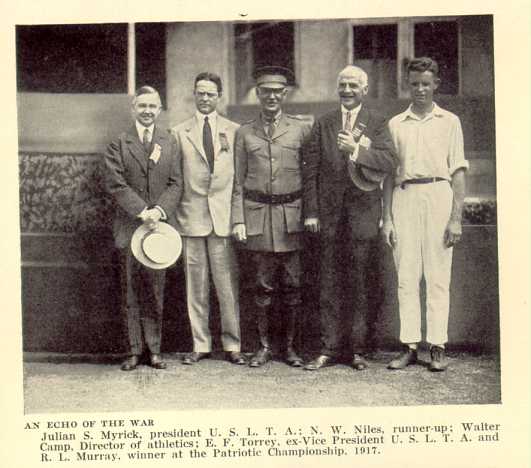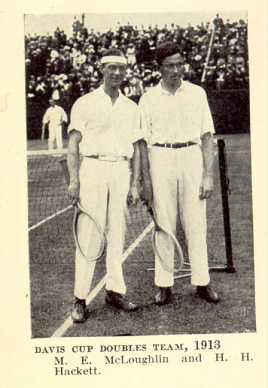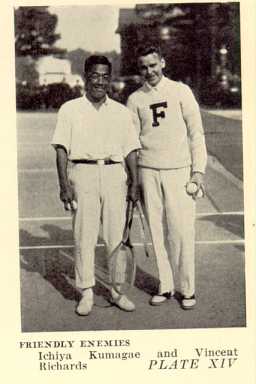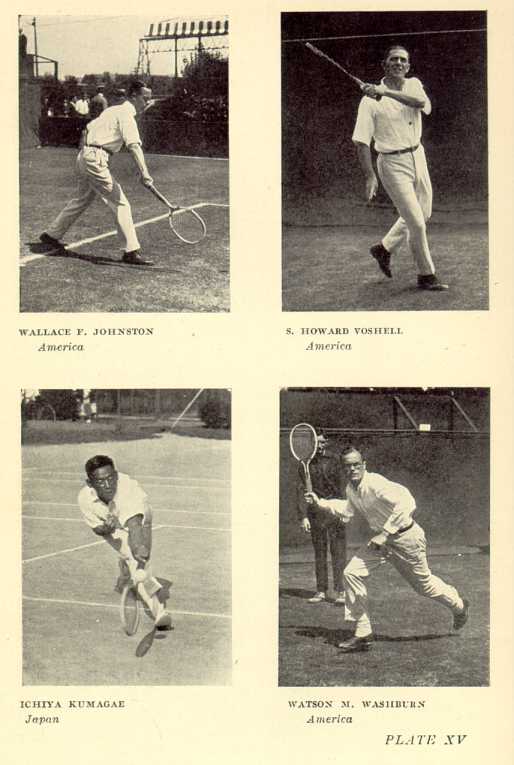| CHAPTER XVII FAMOUS WOMEN PLAYERS The Art of Lawn Tennis | ||
17. CHAPTER XVII
FAMOUS WOMEN PLAYERS
Women's Tennis
THE great boom that featured the whole tennis season of 1921 in America found one of its most remarkable manifestations in the increased amount of play, higher standard of competition and remarkable growth of public interest in women's tennis.
England has led, and still leads, the world in women's tennis. The general standard of play is on a higher scale and there is more tournament play in England than elsewhere. France, with Mlle. Suzanne Lenglen, Mme. Billout (Mlle. Brocadies) and Mme. Golding, forces England closely for European supremacy, but until recent years America, except for individuals, has been unable to reach the standard of women's tennis found abroad.
Miss May Sutton, now Mrs. Thomas H. Bundy, placed American colours in the field by her wonderful performances in winning the World's Championship at Wimbledon more than a decade ago, but after her retirement America was forced to content itself with local honors.
Neither Miss Mary Browne nor Miss Hazel
Finally in 1920, at the request of the Women's Committee, particularly on the advice of Mrs. George Wightman, the national champion, and Miss Florence Ballin of New York, under whose able guidance the entire schedule was drawn up, the United States Lawn Tennis Association moved the Women's Championship to September. Miss Ballin, following the successful system used in the men's events, organized a schedule that paralleled the big fixtures on the men's schedule and placed in operation "a circuit," as it is called, that provided for tournaments weekly from May to September. Miss Ballin, together with Mrs. Wightman, organised junior tournaments for girls under 18, along the lines used for the boys' events. The response was immediate. Entry lists, which in the old days were
It was a tremendous task of organization that Miss Ballin and her assistants undertook, but they did it in a most efficient manner. Mrs. Molla Bjurstedt Mallory lent her invaluable assistance by playing in as many tournaments as possible. She was a magnet that drew the other players in her wake with an irresistible force.
1920 saw Mrs. Mallory's first invasion of Europe since her American triumphs. Misfortune was her portion. She was ill before sailing and, never at her best on shipboard, a bad voyage completed the wreck of her condition. She had little time for practice in England and it was a player far below her best who went down to crushing de feat at the hands of Mrs. Lambert-Chambers in the semi-final round of the World's Championship at Wimbledon.
Defeated but not discouraged, Mrs. Mallory returned to America and, again reaching her true form, won the championship with ease. She made up her mind the day of her defeat in England that 1921 would again find her on European courts.
The season of 1921 in America opened in a blaze
Early May found Mrs. Mallory on the seas bound for France and England. The story of her magnificent, if losing, struggle in both countries is told elsewhere in this book, but she sailed for home recognised abroad as one of the great players of the world, a thing which many of the foreign critics had not acknowledged the previous year.
The trip of the American team to France, and particularly the presence of Mrs. Mallory, coupled with the efforts of the Committee for Devastated France, finally induced Mile. Suzanne Lenglen, the famous French World's Champion, to consent to come to America. The announcement of her decision started a boom in the game that has been unequalled. Out in California, Mrs. May Sutton Bundy and Miss Mary Kendall Browne, our former champions, heard the challenge and, laying aside the duties of everyday life, buckled on the armour of the courts and journeyed East to do battle with the French wonder girl. Mrs. Mallory, filled with a desire to avenge her defeat in France, sailed for home in time to play in the American championship.
What a marvelous tournament this proved to be! In very truth it was a World's Championship. Mrs. May Sutton Bundy, former world's champion, back again after fifteen years with all her old charm of
The stage was set for the sensational, and for once it occurred. The God of Luck took a hand in the blind draw and this resulted in all the stars, with the exception of Miss Mary Browne, falling in one half. Mile. Suzanne Lenglen was drawn against Miss Eleanor Goss, while Mrs. Mallory met Mrs. Marion Zinderstein Jessop, her famous rival, in the first round, with the winners of these matches to play each other in the second.
Unfortunately illness prevented Mile. Lenglen from sailing at her appointed time. She arrived in America but one day before the tournament was to start. The officials of the United States Lawn Tennis Association wisely granted Mile. Lenglen another day's grace by holding her match with Miss Goss until Tuesday. Mrs. Mallory, playing brilliantly, crushed Mrs. Jessop on Monday.
Then came the deluge! Miss Goss, taken suddenly
There is no question but what it was a terribly hard position for Mlle. Lenglen. Mrs. Mallory was physically and mentally on the crest. She had lived for this chance ever since Mlle. Lenglen had defeated her at St. Cloud in June. Now it was hers and she determined to make the most of it.
The two women stepped on the court together. Mlle. Lenglen was obviously and naturally nervous. Mrs. Mallory was quietly, grimly confident. Her whole attitude said "I won't be beaten." Every one of the 10,000, spectators felt it and joined with her in her determination. It was an electric current between the gallery and the player. I felt it and am sure that Mlle. Lenglen must have done so too. It could not fail to impress her. The match opened with Mrs. Mallory serving. From the first ball, the American champion was supreme. Such tennis I have never seen and I verily believe it will never be seen again. The French girl was playing well. She was as good as when she defeated Mrs. Mallory in France or Miss Ryan in England, but this time she was playing a super-woman who would not miss. One cannot wonder her nerves, naturally overwrought, broke under the strain.
Mrs. Mallory, in an exhibition of faultless, flawless tennis, ran through the first set 6-2. It was at this point Mlle. Lenglen made her mistake.
She had trouble getting her breath and was obviously feeling the strain of her tremendous exertions. She defaulted the match! Mrs. Mallory walked from the court conqueror, clearly the superior of the much vaunted world's champion.
It is regrettable Mlle. Lenglen defaulted, for if she had played out the match, everyone would have made full allowance for her defeat, due, it would be said, to natural reaction from her recent sea journey. No one would have been quicker to make allowance for Mlle. Lenglen than Mrs. Mallory herself. The whole tennis public deeply regretted an incident that might well have been avoided.
Mrs. Mallory was the woman of the hour. She marched on to victory and successfully defended her title by virtue of victories over Mrs. May Sutton Bundy in the semi-final and Miss Mary Browne in the final.
Marvellous Molla! World's Champion in 1921 beyond shadow of dispute!
It is deplorable that the quite natural reaction and nervous upset, coupled with a return of her bronchial illness, forced Mlle. Lenglen to return to France before she was able to play her exhibition tour for the Committee for Devastated France. Possibly 1922 will find conditions more favorable and the Gods of Fate will smile on the return of Mlle. Lenglen to America.
MRS. FRANKLIN I. MALLORY
(Molla Bjurstedt)
One of the most remarkable personalities in the tennis world is Mrs. Molla Bjurstedt Mallory, the American Champion and actually Champion of the World, 1921.
Mrs. Mallory is a Norsewoman by birth. She came to America in 1915. In 1919 she married Franklin I. Mallory, and thus became an American citizen.
It is a remarkable game which Mrs. Mallory has developed. She has no service of real value. Her overhead is nil, her volleying is mediocre; but her marvellous forehand and backhand drives, coupled with the wonderful court-covering ability and fighting spirit that have made her world-famous, allow her to rise above the inherent weaknesses of those portions of her game and defeat in one season all the greatest players in the world, including Mlle. Suzanne Lenglen.
Mrs. Mallory, with delightful smile, never failing sportsmanship and generosity in victory or defeat, is one of the most popular figures in tennis.
MRS. THOMAS C. BUNDY
(May Sutton)
It is said "they never come back," but Mrs. May Sutton Bundy has proved that at least one
great athlete is an exception to the saying. Fifteen years ago, May Sutton ruled supreme among the women tennis stars of the world.
In 1921 Mrs. May Sutton Bundy, mother of four children, after a retirement of over a I decade, returned to the game when Mlle. Lenglen announced her intention of invading America. If Mlle. Lenglen's visit to our shores did nothing more than bring Mrs. Bundy and Miss Browne back to us, it was well worth while.
Mrs. Bundy in 1921 was still a great player. She has a peculiar reverse twist service, a wonderful forehand drive, but with excessive top spin, a queer backhand poke, a fine volley and a reliable overhead. Much of her old aggressiveness and speed of foot are still hers. She retains all of her famous fighting spirit and determination, while she is even more charming and delightful than of old. She is a remarkable woman, who stands for all that is best in the game.
MARY KENDALL BROWNE
The return of another former National Champion in 1921 in the person of Mary K. Browne, who held the title in 1912, '13 and '14, brought us again a popular idol. The tennis public has missed Miss Browne since 1914 and her return was in the nature of a personal triumph.
Mary Browne has the best produced tennis game of any American woman. It is almost if not quite
Miss Browne is a trig and trim little figure on the court as she glides over its surface. It is no wonder that her public love her.
MRS. GEORGE WIGHTMAN
(Hazel Hotchkiss)
The woman to whom American tennis owes its greatest debt in development is Hazel Hotchkiss Wightman, National Champion 1909, '10, '11 and 1919. Mrs. Wightman has practically retired from singles play. Her decision cost the game a wonderful player. She has a well placed slice service, a ground game that is essentially a chop fore-and backhand, although at times she drives off her forehand. She volleys remarkably. She is the equal of Mary Browne in this department, while her overhead is the best of any woman in the game.
Hazel Wightman is as clever a court general and tactician, man or woman, as I have ever known. She has forgotten more tennis than most of us ever learn. She is the Norman Brookes of woman's tennis.
It is not only in her game that Mrs. Wightman
Mrs. Wightman and Miss Florence Ballin are the prime factors in the new organization of woman's tennis that has resulted in the great growth of the game in the past two years.
MRS. JESSOP
(Marion Zinderstein)
There is no player in tennis of greater promise than Marion Zinderstein Jessop. She has youth, a wonderful game, the result of a sound foundation given her by Hazel Wightman, and a remarkable amount of experience for so young a girl. She has a beautiful fast service, but erratic. Her ground-game is perfectly balanced, as she chops or drives from either side with equal facility. She volleys with great severity and certainty. Her overhead is possibly her weakest point. She lacks the confidence that her game really deserves.
HELEN WILLS
The most remarkable figure that has appeared on the horizon of woman's tennis since Suzanne Lenglen first flashed into the public eye, is little Helen Wills of California, Junior Champion of
The tennis this child plays is phenomenal. She serves with the power and accuracy of a boy. She drives and chops forehand and backhand with reckless abandon. She rushes to the net and kills in a way that is reminiscent of Maurice McLoughlin. Suddenly she dubs the easiest sort of a shot and grins a happy grin. There is no doubt she is already a great player. She should become much greater. She is a miniature Hazel Wightman in her game. Above all, she is that remarkable combination, an unspoiled child and a personality.
There are many other players of real promise coming to the front. Boston boasts of a group that contains Mrs. Benjamin E. Cole (Anne Sheafe) who has made a great record in the season of 1921; Miss Edith Sigourney, who accompanied Mrs. Mallory abroad, Miss Leslie Bancroft and Mrs. Godfree. There are Miss Martha Bayard, Miss Helen Gilleandean, Mrs. Helene Pollak Folk, Miss Molly Thayer, Miss Phyllis Walsh and Miss Anne Townsend in New York and Philadelphia.
France
MLLE. SUZANNE LENGLEN
There is no more unique personality, nor more remarkable player among the women than Mademoiselle
Mlle. Lenglen's fame rests on her drive. Strange though it may seem, her drive is the least interesting part of her game. Mlle. Lenglen uses a severe overhead service of good speed. It is a remarkable service for a woman, one which many men might do well to copy. Her famous forehand drive is a full arm swing from the shoulder. It meets the ball just as Mlle. Lenglen springs in the air. The result is pictorially unique, but not good tennis. She loses speed and power by this freak. Her backhand is beautifully played, from perfect footwork, with a free swing and topped drive. It is a remarkable stroke. Her volleying is perfect in execution and result. She hits her overhead smash freely with a "punch" that is as great as many men. It is as fine an overhead as that of Mrs. George Wightman, the American Champion.
Mlle. Lenglen's speed of foot is marvellous. She runs fast and easily. She delights in acrobatic jumps, many of them unnecessary, at all times during her play. She is a wonderful gallery player, and wins the popularity that her dashing style deserves. She is a brilliant court general, conducting her attack with a keen eye on both the court and the gallery.
Mlle. Lenglen is not outstanding among the women players of the world, in my opinion. She is probably the best stroke player in the world to-day, yet Mrs. Lambert Chambers, Mrs. George Wightman, Miss Elizabeth Ryan, Mrs. Franklin L. Mallory (formerly Miss Molla Bjurstedt), Miss Mary Browne, and Mrs. May Sutton Bundy are all in her class in match play. There is no woman playing tennis that has the powerful personality of Mlle. Lenglen. Her acrobatic style and grace on the court form an appeal no gallery can resist. Her very mannerisms fool people into considering her far greater than she really is, even though she is a wonderful player.
MME. BILLOUTT
(Mlle. Brocadies)
Second only to Suzanne Lenglen in France is Mme. Billoutt, formerly Mlle. Brocadies, once the idol of the Paris tennis public. This remarkable player has as perfectly developed a game as I have seen. Her actual stroking is the equal of Mlle. Lenglen. Her strokes are all orthodox, flat racquet ones. Her ground game is based wholly on the drive, fore-or backhand. She has grown rather heavier in the last few years and consequently slowed up, but she is still one of the great players of the world.
England
In marked contrast to the eccentricities of Mlle. Lenglen one finds the delightfully polished style of Mrs. Lambert Chambers. Mrs. Chambers has a purely orthodox game of careful execution that any student of the game should recognize as the highest form of tennis strokes.
Mrs. Chambers serves an overhead delivery of no particular movement. She slices or "spoons" her ground strokes, forehand or backhand. She seldom volleys or smashes. Her only excursions to the net are when she is drawn to the net.
It is not Mrs. Chambers' game itself so much as what she does with it, that I commend so highly. Her change of pace and distance is wonderfully controlled. Her accuracy marvellous. Her judgment is remarkable, and the way in which she saves undue exertion is an art in itself. She gets a wonderful return for her outlay of effort.
Hers is a personality of negation. Her manner on the court is negative, her shots alone are positive. She is never flustered, and rarely shows emotion.
Mrs. Chambers is the "Mavro" of women as regards her recovering ability. Her errors are reduced to a minimum at all times. To err is human; but at times there is something very nearly inhuman about Mrs. Chambers' tennis.
ELIZABETH RYAN
The English-American star Elizabeth Ryan is another player of marked individuality. Born in California, Miss Ryan migrated to England while quite young. For the past decade "Bunny," as she is called, has been a prominent figure in English and Continental tournaments.
Miss Ryan has a queer push-reverse twist service that is well placed but carries little speed. She chops viciously forehand and backhand off the ground and storms the net at every opening. Her volleying is crisp and decisive. Overhead she is severe but erratic. She is a dogged fighter, never so dangerous as when behind. Her tactics are aggressive attack at all times, and if this fails she is lost.
Although Miss Ryan is an American by birth she must be considered as an English player, for her development is due to her play in England.
MRS. BEAMISH
(May Sutton)
This English player is an exponent of the famous base-line game of the country. She drives, long deep shots fore-and backhand, corner to corner, chasing her opponent around the court almost impossible distances. Her service volleying and overhead are fair but not noteworthy. Another player of almost identical game and of almost equal class is Mrs. Peacock, Champion of India. Her whole game is
Among the other women in England who are delightfully original in their games are Mrs. Larcombe, the wonderful chop-stroke player, whose clever generalship and tactics place her in the front rank, and Mrs. M`Nair, with her volleying attack.
Women's tennis in England is on a slightly higher plane at this time than in America; but the standard of play in America is rapidly coming up. International competition between women on the lines of the Davis Cup, for which a trophy has previously been offered by Lady Wavertree in England, and in 1919 by Mrs. Wightman in America, and twice refused by the International Federation, would do more than any other factor to place women's tennis on the high plane desired. This plan has succeeded for the men, why should it not do as well for the women?
| CHAPTER XVII FAMOUS WOMEN PLAYERS The Art of Lawn Tennis | ||



